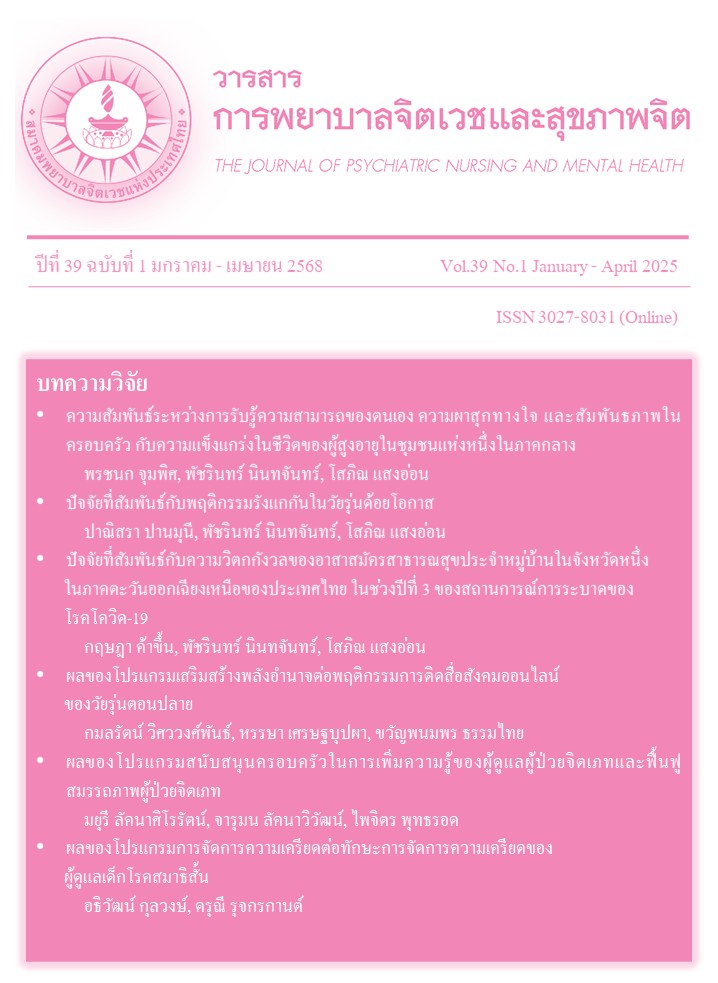EFFECT OF THE EMPOWERMENT ENHANCEMENT PROGRAM ON SOCIAL MEDIA ADDICTION BEHAVIOR OF LATE ADOLESCENTS
Main Article Content
Abstract
Objective: This quasi-experimental design aimed to study the effect of an empowerment enhancement program on the social media addiction behaviors of late adolescents.
Methods: The twenty-six samples were late adolescents, aged 19-21 years, who studied in an educational institution under the Office of Vocational Education Commission, Ministry of Education, Northern region. They were divided into two groups of 13 each: the experimental group that received the program and the control group that did not receive the program. The research instruments included 1) a general data questionnaire, 2) a social media addiction test, 3) an assessment of perceived empowerment and 4) an empowerment program on social media addiction behaviors of late adolescents based on Gibson's concept (Gibson, 1995). The program consisted of 8 activities and lasted for 4 weeks. It was conducted twice a week for 45-60 minutes each session. Data were analyzed using descriptive statistics, independent t-tests, and dependent t-tests.
Results: 1) One month after receiving the empowerment enhancement program, the experimental group's average score on social media addicted behaviors of late adolescents was statistically significantly lower than before receiving the program (p < .05). 2) One month after receiving the empowerment enhancement program, the average score on social media addicted behaviors of late adolescents in the experimental group was statistically significantly lower than that of the control group (p < .05).
Conclusion: The results of this study showed that the empowerment enhancement program on social media addiction behaviors of late adolescents could reduce their social media addicted behaviors. Therefore, this program should be used to further reduce social media addicted behavior in this group.
Article Details

This work is licensed under a Creative Commons Attribution-NonCommercial-NoDerivatives 4.0 International License.
บทความที่ได้รับการตีพิมพ์แล้ว เป็นลิขสิทธิ์ของสมาคมพยาบาลจิตเวชแห่งประเทศไทย
References
กชพร เผือกผ่อง, นุชนาถ บรรทุมพร, และชมชื่น สมประเสริฐ. (2561). ผลของโปรแกรมการเสริมสร้างพลังอำนาจต่อการควบคุมตนเองของผู้เสพติดแอมเฟตามีน. วารสารพยาบาลทหารบก, 19(ฉบับพิเศษ), 118-128.
ครองรัตน์ ดุลลาพันธ์. (2561). พฤติกรรมการใช้เครือข่ายสื่อสังคมออนไลน์และปัจจัยทางจิตที่พยากรณ์ภาวะโรคซึมเศร้า (วิทยานิพนธ์ปริญญามหาบัณฑิต). สถาบันบัณฑิตพัฒนบริหารศาสตร์.
จุฑามาศ ทองประดับ, ทัศนาทวีคูณ และพัชรินทร์ นินทจันทร์. (2562). ความสัมพันธ์ระหว่างภาวะติดเฟซบุ๊กกับความรู้สึกมีคุณค่าในตนเองและภาวะซึมเศร้าในนักเรียนมัธยมศึกษาตอนปลาย. วารสารพยาบาลสภากาชาดไทย, 12(2), 116-133.
ชาญวิทย์ พรนภดล, และคณะ. (2556). แบบทดสอบการติดสื่อสังคมออนไลน์ (Social Media Addiction Test: SMAT). http://www.cumentalhealth.com/index.php?lay=show&ac=article&Id=539909352
ชัชช์รวี กลิ่นหอม. (2563). ความสัมพันธ์ระหว่างการเสริมพลังอำนาจและการเห็นคนค่าในตนเองของพนักงานในผู้จำหน่ายยานยนต์. [การค้นคว้าอิสระปริญญามหาบัณฑิต]. มหาวิทยาลัยเทคโนโลยีพระจอมเกล้าพระนครเหนือ.
เชาวลิต ศรีเสริม และลักขณา ชอบเสียง. (2563). สื่อสังคมออนไลน์กับสุขภาพจิตวันรุ่น: จุดแข็ง ข้อจำกัด และการติดสื่อสังคมออนไลน์. วารสารการบริหารนิติบุคคลและวัฒนธรรมท้องถิ่น, 6(6), 355-370.
ดาราวรรณ ต๊ะปินตา. (2558). คู่มือการบำบัดความคิดและพฤติกรรมของผู้ป่วยโรคซึมเศร้า (ฉบับปรับปรุง ครั้งที่ 2/2558). https://www.thaidepression.com/www/doc58/ cbt.pdf
ดลยา สุขปิติ. (พฤษภาคม 2560). แบ่งเวลาให้ชีวิตจากการติดโชเซียล. http://lib3.dss.go.th/fulltext/dss_knowledge/blpd-5-2560-social.pdf
นภัสถ์ หาญพรชัย, คมสัน สุริยะ, และแพรรฎา พรหมวงศ์. (2557). ผลกระทบทางเศรษฐกิจและสังคมของโซเชียลเน็ตเวิร์กผ่านโมบายบรอดแบนด์ [วิทยานิพนธ์ปริญญามหาบัณฑิต]. มหาวิทยาลัยเชียงใหม่.
พิมพาภรณ์ กลั่นกลิ่น. (2563). การพยาบาลเด็กและวัยรุ่น. มหาวิทยาลัยเชียงใหม่.
พิมพ์รำไพ บุณย์ศุภา. (2563). ศึกษาเปรียบเทียบพฤติกรรมการสูบบุหรี่ของเจ้าหน้าที่โรงพยาบาลอุดรธานี ระหว่างก่อนและหลังการใช้โปรแกรมเสริมสร้างพลังอำนาจด้านจิตใจ.
วารสารการแพทย์โรงพยาบาลอุดรธานี, 28(1), 61-70.
มาโนชญ์ ขุนค้ำ, และฐิติอาภา ตั้งค้าวานิช. (2561). ผลของโปรแกรมเสริมสร้างพลังอำนาจต่อการลดการสูบบุหรี่ของประชาชน อำเภอบึงสามัคคี จังหวัดกำแพงเพชร. วารสารการพยาบาลและสุขภาพ, 12(1), 48-57.
มธุรดา สุวรรณโพธิ์. (2566). วัยรุ่นติดโซเชียล. https://www.camri.go.th/th/home/infographic/infographic-505
สยาภรณ์ เดชดี, และอรวรรณ หนูแก้ว. (2564). การพัฒนาและผลของโปรแกรมการเสริมสร้างพลังอำนาจต่อพฤติกรรมการดูแลตนเองในผู้ป่วยโรคจิตจากสารเสพติด. วารสารการพยาบาลจิตเวชและสุขภาพจิต. 35(1). 91-111.
สำนักงานสถิติแห่งชาติ. (2563). การสำรวจการมีการใช้เทคโนโลยีสารสนเทศและการสื่อสารในครัวเรือน พ.ศ.2563. กรุงเทพฯ: สำนักงานสถิติแห่งชาติ.
สดใส คุ้มทรัพย์อนันต์. (2554). คู่มือครอบครัวบำบัดสำหรับผู้ปฏิบัติงานด้านพัฒนาการเด็กและสติปัญญา. กรุงเทพฯ: บริษัท พิมพ์ดี จำกัด.
อมร โต๊ะทอง. (2555). พฤติกรรมและผลกระทบการใช้อินเทอร์เน็ตผ่านโทรศัพท์เคลื่อนที่ของวัยรุ่นในเขตกรุงเทพมหานคร [วิทยานิพนธ์ปริญญามหาบัณฑิต]. สถาบันเทคโนโลยีพระจอมเกล้าพระนครเหนือ.
อมรรัตน์ วงศ์โสภา, เสกสรร สายสีสด, และแน่งน้อย ย่านวารี. (2558). พฤติกรรมการใช้และผลกระทบของสื่อออนไลน์ประเภทเฟซบุ๊กต่อการดำเนินชีวิตของนักศึกษา กรณีศึกษามหาวิทยาลัยราชภัฏเลย. วารสารวิจัยและพัฒนา มหาวิทยาลัยราชภัฏเลย, 10(33), 1-10.
อุลิศ สมบัติแก้ว และปลดา เหมโลหะ. (2557). ผลของโปรแกรมการเสริมสร้างพลังอำนาจผู้ดูแลในการจัดการพฤติกรรมรุนแรงของผู้ป่วยจิตเภท. วารสารพยาบาลสงขลานครินทร์, 36(2),93-103.
Burns, N., & Grove, S. K. (2005). The practice of nursing research: Conduct, critique, and utilization (5th ed.). Missouri.
Cohen, J. (2013). Statistical power analysis for the behavioral sciences. New York: Academic Press.
Coopersmith, S. (1981). The antecedents of self-esteem (2nd ed.). Consulting Psychologist Press.
Denis, R. & Manuel, E. (2006). The ‘Drug–Crime Link’ from a Self-Control Perspective. European Journal of Criminology, 3(1), 33-67.
Gibson, C. H. (1995). The process of empowerment in mothers of chronically ill children. Gulzade Journal of Advanced Nursing, 21(6), 1201-1210.
Gulzade, U. & Serap, B. (2018). Evaluation of a School-Based Program for Internet Addiction of Adolescents in Turkey. Journal of Addictions Nursing, 29(1), 43-49.
Krasnova, H., Wenninger, H., Widjaja, T., & Buxmann, P. (2013). Envy on Facebook: A hidden threat to users’ life satisfaction?. International Conference on Wirtschaftsinformatik. Leipzig.
Kuss, D. J., & Griffiths, M. D. (2012). Online gaming addiction in adolescence: A literature review of empirical research. Journal of Behavioural Addiction, 1(1), 3-22.
Marwell, G. (1966). Adolescent powerlessness and delinquent behavior. Social Problems, 14(1), 35–47.
Maslow, A.H. (1970). Motivation and Personality (2nd ed.). Harper & Row.
Przepiorka, A.M., Blachnio, A., Miziak, B., & Czuczwar, S.J. (2014). Clinical approaches to treatment of Internet addiction. Pharmacological Report, 66(2), 187-191.
Uyaroglu, A.K., & Ozcan, A. (2022). The effect of empowerment training in protecting adolescents from substance abuse on self-efficacy, self-esteem, and assertiveness levels. The Turkish Journal on Addictions. 9(3), 269-276.
Yalom, I. D. (1995). The theory and practice of group psychotherapy (4th ed.). Basic Books.
Wilcox, K., & Stephen, A. T. (2013). Are close friends the enemy? Online social networks, self-esteem, and self-control. Journal of Consumer research, 40(1), 90-103.
Woodward, M. (2023, June 23). Social media addiction statistics: who is addicted and what are the consequences. https://www.searchlogistics.com/learn/statistics/social-media-addiction-statistics/
Zauderer, S. (2023, November 11). 121 Social Media Addiction Statistics Worldwide. https://www.crossrivertherapy.com/ research/social-media-addiction-statistics.

